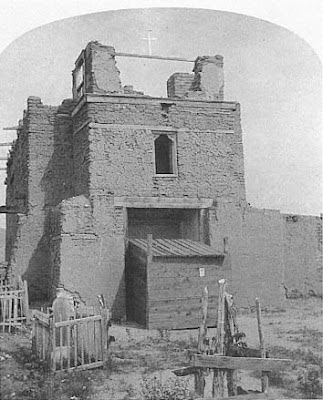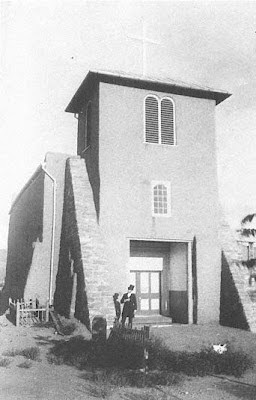 I took this picture of San Miguel Mission Church/Chapel in Santa Fe in May of 2004 during one of innumerable vacations in The Land Of Enchantment over the last thirty years or so. I've always liked the picture -- despite the primitive digital camera I was using at the time -- because of the massing of the building, and the dove seen in flight just above the cross. Mirable dictu et stupor mundi, eh?
I took this picture of San Miguel Mission Church/Chapel in Santa Fe in May of 2004 during one of innumerable vacations in The Land Of Enchantment over the last thirty years or so. I've always liked the picture -- despite the primitive digital camera I was using at the time -- because of the massing of the building, and the dove seen in flight just above the cross. Mirable dictu et stupor mundi, eh?Yes, well. These things happen in New Mexico, more often than you might think.
That vacation also included my first trip out to Chaco Canyon. Stupor mundi, indeed. I would go back any time, but the opportunity doesn't arise as often as I'd like.
It's quite a way out to Chaco from our place in the East Mountains, though not as far as many places are from practically any place in California. But that washboard road from the highway at Nageezi is something of a deterrent. People arrive at the Chaco Canyon Visitor's Center in full dudgeon because of "that road", yowling their heads off because "it practically destroyed" their car.
Yes, well. It's New Mexico. Take it slow and easy, you'll be fine. And so will your car. Drive around Santa Fe on a sunny day and you'll find that many residential streets aren't paved. Go out of town any distance, and you'll find unpaved roads everywhere.
It's not so far to Santa Fe from our little place in the country and the highway north runs through spectacular mountain scenery; the road I take into town from I-25 (Old Pecos Trail onto Old Santa Fe Trail right to the Plaza at La Fonda) goes by all the historical sights. Well, most of them. It goes right through El Barrio de Analco where San Miguel is located -- said to have been built as a mission church for the salvation of the Tlaxcala Indians who accompanied the Spanish when they decided it was time and the opportunity was ripe to settle New Mexico. According to the stories, San Miguel was the first church built in Santa Fe, and for some time it was the only church in Santa Fe.
Given the disputatious nature of the settlers, however, San Miguel's first incarnation had a rather dramatic conclusion.
Relations among the civil authorities, the military, and the clergy were frequently stormy, and in the late 1630s, with the governorship of Luis de Rosas, the trouble was brought to a head. Attempts to resolve the problems had been in vain. When Fray Bartolomé Romero and Fray Francisco Núñez were sent to Santa Fe in 1640 to meet with the governor and attempt a reconciliation, he verbally abused them, beat them with a stick, and had them imprisoned. The friars were later released, but the church was closed and its bells removed.The culmination of the disputes between church and state was the razing of San Miguel in 1640, the adobes presumably taken down with the vigas and reused in other construction. The drama did not end with demolition, however. Late one night Nicolás Ortiz discovered his wife in Governor Rosas' house, which precipitated a turmoil that resulted in the murder of the excommunicated former governor some weeks later. Rosas was absolved of his activities against the religious by a priest named Juan de Vidania, who was arrested later by the Inquisition but escaped while en route to Mexico. This complex, fascinating, and bizarre chapter in New Mexican history brought into high contrast the chronic antagonisms within the civil administration and the church as well as those between church and state. -- from Sanctuaries of Spanish New Mexico. Berkeley: University of California Press, 1993
How can you not love New Mexico with stories like that abounding?
San Miguel was rebuilt, but like most of the churches in New Mexico, it was burned during the Pueblo Revolt. It was restored not soon after the Reconquest, reopening for services some time around 1710, and it repeatedly fell to ruin and was rebuilt thereafter. The current appearance of the church differs significantly from its historic appearance(s); photos taken in the 19th century show repeated transformations.
1872

1880

1884
As far as I can tell, the current appearance dates from about 1955, though most of the elements of the present appearance were in place prior to then.
Not all of New Mexico is as determined as Santa Fe to enforce Colonial and Pueblo architectural styles, so parts of the built environment of the state seem strangely out of place compared to those areas which do maintain Colonial and Pueblo styles, as if contemporary parts of Texas and Colorado had been plopped down on in the midst of the ancient mud and stone buildings (or their ruins or their imitations) that seem to have grown out of the land itself.
John Gaw Meem is the godfather of the contemporary New Mexico Pueblo-Colonial architectural style, and he's both beloved and hated for it. He's been criticized for slavishly following the styles of the past -- which is not what he did at all. His Zimmerman Library at the University of New Mexico in Albuquerque is an example of how he adapted the styles of yore to contemporary requirements, and it is hard to find anyone who's experienced the Zimmerman who is anything but delighted by it.
 This is obviously not a copy of anything built in the past, and the interior is just a brilliant reimagining of New Mexico's spirit of place and its traditional architectural values
This is obviously not a copy of anything built in the past, and the interior is just a brilliant reimagining of New Mexico's spirit of place and its traditional architectural values
1938
and as seen in this video:
The residences and other buildings that Meem designed are treasured by New Mexicans today for their simplicity and beauty and how naturally they seem to integrate with the land and nature, in stark contrast to most contemporary architecture that seeks an almost desperate contrast with nature. By evoking traditional style without copying, and by adapting New Mexico's traditional architecture to contemporary needs, Meem found the contemporary truth within tradition styles.
San Miguel is considered somewhat anomalous compared to most of the mission churches in New Mexico because it doesn't quite follow the pattern of many of the others, yet its cubical masses seem to have had a strong influence on what came after.
The anomaly is the Romanesque stone Cathedral Basilica of San Francisco de Assisi in Santa Fe, beloved in its own right, but almost as alien to the landscape of New Mexico as a Texas suburban ranch house.

But in his brilliance, Father Roca adapted the style of the Santa Fe Cathedral to New Mexico's native architecture at the Santuario de Chimayo.

So it all fits together in the by and bye.
Land of Enchantment, indeed.

No comments:
Post a Comment